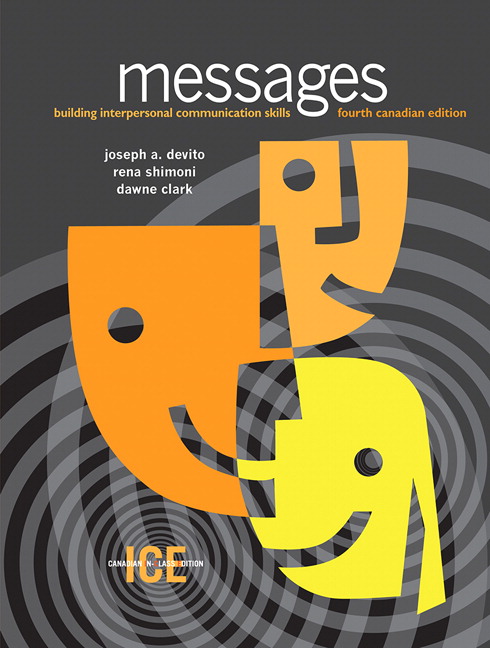Test Bank for Messages: Building Interpersonal Communication Skills, Fourth Canadian Edition, Canadian In-Class Edition, 4/E 4th Edition
$35.00 Original price was: $35.00.$26.50Current price is: $26.50.
Test Bank for Messages: Building Interpersonal Communication Skills, Fourth Canadian Edition, Canadian In-Class Edition, 4/E 4th Edition
This is completed downloadable of Test Bank for Messages: Building Interpersonal Communication Skills, Fourth Canadian Edition, Canadian In-Class Edition, 4/E 4th Edition

Product Details:
- ISBN-10 : 0205024351
- ISBN-13 : 978-0205024353
- Author: Rena Shimoni, Dawne Clarke
Messages: Building Interpersonal Communication Skills, Fourth Canadian Edition, is a practical, task-oriented introduction to the field of interpersonal communication that will help you integrate critical thinking into all aspects of interpersonal communication. The new Fourth Canadian Edition has been updated to include new sections on multicultural communication, workplace communication, computer-mediated-communication, ageism and heterosexism, nonverbal communication, anger, dating violence, and conflict management.
The combination of text and exercises will help you to develop interpersonal skills, discover the influence of culture and gender on interpersonal communication, and understand the importance of listening in interpersonal communication. Featuring a new full-colour design, numerous activity boxes, a study guide, critical thinking questions, and access to MySearchLab, Messages is designed to enhance your engagement with this exciting subject.
Table of Content:
Chapter 2
Interpersonal Communication and Culture
1) Culture means all of the following EXCEPT
A) a lifestyle of a group of people.
B) other cultures attempting to develop to the extent Canadian culture has.
C) values, beliefs, behaviour.
D) language, art, religion.
Answer: B
Diff: 1
Page Ref: 24
2) Intercultural value conflict areas in North America include
A) acceptance of others.
B) contact with other cultures.
C) communication between persons of different cultures.
D) differences in status and hierarchical rank.
Answer: A
Diff: 1
Page Ref: 26
3) Intercultural communication means
A) the transmission of culture from one generation to another.
B) processes that modify a person’s culture through contact with other cultures.
C) communication between persons of different cultures.
D) all that a social group has produced and developed.
Answer: C
Diff: 1
Page Ref: 25
4) Acculturation means
A) the transmission of culture from one generation to another.
B) processes that modify a person’s culture through contact with other cultures.
C) communication between persons of different cultures.
D) all that a social group has produced and developed.
Answer: B
Diff: 1
Page Ref: 24
5) Acculturation occurs more quickly for
A) people who are not familiar with the host culture.
B) people who are less educated.
C) people who are risk-takers.
D) people who are dissimilar from the host culture.
Answer: C
Diff: 1
Page Ref: 24
6) Generally Canadians are proud of their
A) mosaic concept.
B) international communication.
C) melting pot concept.
D) ethnocentricity.
Answer: A
Diff: 1
Page Ref: 25
7) The term “intercultural” is used broadly to describe
A) all barriers to communication.
B) all forms of communication among persons from different groups.
C) all information that is explicitly stated in verbal messages.
D) all forms of communication within a cultural group.
Answer: B
Diff: 1
Page Ref: 25
8) Intercultural communication can be used to describe all of the following situations EXCEPT
A) communication between Muslims and Catholics.
B) communication between homosexuals and heterosexuals.
C) communication between doctors and nurses.
D) communication between senior citizens and young people.
Answer: C
Diff: 1
Page Ref: 26
9) Another frequent difference and source of misunderstanding between high- and low-context cultures is __________.
A) public praise
B) acceptance of others
C) face-saving
D) family relations
Answer: C
Diff: 1
Page Ref: 29
10) Which of the following is NOT a true statement about a collectivist culture?
A) You are responsible for the entire group.
B) Success is measured by your contribution to the group.
C) You take pride in your similarity to other members of the group.
D) Distinctions between in-group members and out-group members are unimportant.
Answer: D
Diff: 1
Page Ref: 28
11) Cultures differ in terms of their
A) orientation, context, and masculinity.
B) individualism, content, and masculinity.
C) orientation, content, and masculinity.
D) orientation, individualism, and time.
Answer: A
Diff: 1
Page Ref: 27
12) In a low context culture, the communication
A) does not come from verbal messages.
B) comes from formal transactions.
C) comes from written contracts.
D) comes from verbal messages.
Answer: A
Diff: 1
Page Ref: 28
13) Which of the following is NOT true of a masculine culture?
A) The emphasis is placed on material success.
B) Children are socialized to be assertive, ambitious, and competitive.
C) Marks in school are given less importance.
D) Conflicts are confronted directly.
Answer: C
Diff: 1
Page Ref: 30
14) Which of the following statements is NOT true about an individualistic/low context culture?
A) Success depends on you surpassing others.
B) Personal relationships are extremely important.
C) Directness is valued.
D) Little time is spent getting to know each other in meetings.
Answer: B
Diff: 1
Page Ref: 28
15) An example of ethnocentrism is
A) civil war.
B) ignoring differences.
C) behaving mindlessly.
D) teaching children about their heritage.
Answer: A
Diff: 1
Page Ref: 31
16) An example of being mindful is
A) forgetting where you left your key.
B) failing a test.
C) ignoring differences among cultures.
D) being afraid to touch a person with a non-communicable illness.
Answer: D
Diff: 1
Page Ref: 31
17) In a mindful state,
A) we are non-rational.
B) we resort to a critical-thinking mode.
C) we recognize other cultures are inferior.
D) we ignore barriers and gateways to intercultural communication.
Answer: B
Diff: 1
Page Ref: 32
18) Knowing one’s tendency toward ethnocentrism
A) is depressing.
B) may help you avoid it.
C) will hamper intercultural communication.
D) can only happen after living in other cultures.
Answer: B
Diff: 1
Page Ref: 31
19) The following are methods to improve intercultural communication:
A) reduce ethnocentrism, be mindful, face fears, avoid overattribution, and adjust your communication
B) remove ethnocentrism, be mindless, face fears, avoid overattribution, and adjust your communication
C) reduce ethnocentrism, ignore differences, face fears, be mindful, and adjust your communication
D) reduce ethnocentrism, ignore differences, face fears, and avoid overattribution
Answer: A
Diff: 1
Page Ref: 31–38
20) A high-context culture is also
A) a collectivist culture.
B) an individualistic culture.
C) an ethnocentric culture.
D) a competitive culture.
Answer: A
Diff: 1
Page Ref: 28
21) The following are all effective strategies to use during intercultural communication EXCEPT
A) communicate positiveness.
B) communicate expressiveness.
C) use expediency.
D) use immediacy.
Answer: C
Diff: 1
Page Ref: 34
22) Culture shock results from your feelings of
A) dismissing a valid argument.
B) alienation, conspicuousness, and difference from everyone else.
C) credibility and difference.
D) credibility and alienation.
Answer: B
Diff: 1
Page Ref: 39
23) Culture shock refers to
A) different electrical voltage in different countries.
B) a psychological reaction to being in a very different culture.
C) a pleasant sense of excitement at being in a different culture.
D) an unusual reaction not normally felt by most people experiencing a new culture.
Answer: B
Diff: 1
Page Ref: 38
24) Which of the following is NOT a stage of culture shock?
A) honeymoon
B) crisis
C) adjustment
D) problem
Answer: D
Diff: 1
Page Ref: 39
25) The textbook identifies North American values that can create intercultural conflict. Which of the following is identified as a North American value?
A) The individual is perceived as a separate entity.
B) Communication follows a predictable formal series of steps.
C) Differences in hierarchical rank are stressed.
D) Time moves slowly.
Answer: A
Diff: 1
Page Ref: 26
26) Communication between African Canadians and Asian Canadians is an example of international communication.
Answer: FALSE
Diff: 1
Page Ref: 27
27) Culture refers to the finer elements of our lifestyles: art, music, drama, dance.
Answer: FALSE
Diff: 1
Page Ref: 24
28) Enculturation, acculturation, and intercultural are the steps in a model of cross-cultural communication.
Answer: FALSE
Diff: 1
Page Ref: 24
29) Acculturation is the process by which you learn the values of your culture.
Answer: FALSE
Diff: 1
Page Ref: 24
30) Members of a high-context culture are reluctant to say no for fear of offending and causing a person to lose face.
Answer: TRUE
Diff: 1
Page Ref: 29
31) Members of a low context culture may see members of a high context culture as vague or underhanded.
Answer: TRUE
Diff: 1
Page Ref: 29
32) Members of a low context culture are reluctant to question the judgments of their superiors.
Answer: FALSE
Diff: 1
Page Ref: 29
33) We are all a little ethnocentric.
Answer: TRUE
Diff: 1
Page Ref: 32
34) When you assume that others are like you, you are implicitly complimenting and affirming them.
Answer: FALSE
Diff: 1
Page Ref: 35
35) We learn our behaviours from our culture.
Answer: TRUE
Diff: 1
Page Ref: 24
36) Describe three differences between individualistic and collectivist cultures.
Answer: See table on page 30
Diff: 2
Page Ref: 30
37) Describe how cultures differ.
Answer: Individualist vs collectivist; high context vs low context; masculinity vs femininity.
Diff: 2
Page Ref: 27
38) Assume you are a consultant to a business person going to do business in a foreign country for the first time. What are primary steps you would recommend in order for that person to experience effective intercultural communication?
Answer: Recognize and reduce your ethnocentrism, be mindful, face fears, recognize differences, recognize meaning differences between verbal and nonverbal messages, avoid over attribution, avoid violating cultural customs, recognize that culture shock is normal, avoid evaluating differences negatively.
Diff: 2
Page Ref: 31–40
39) Identify something in your own experience that demonstrates enculturation. How has it been impacted by acculturation?
Answer: Discuss something learned and then changed through exposure to another culture.
Diff: 2
Page Ref: 24
40) Describe the stages of conscious continuum and explain how they may be helpful to understand what it means to be mindful.
Answer: Unconsciously incompetent, consciously incompetent, consciously competent, unconsciously competent
Diff: 2
Page Ref: 31–32
41) The processes by which a person’s culture is modified through direct contact with another culture is __________. The process by which all that a culture has produced is transmitted from one generation to another is __________.
Answer: acculturation, enculturation
Diff: 1
Page Ref: 24
42) __________ includes all that members of a social group have produced and developed.
Answer: Culture
Diff: 1
Page Ref: 24
43) You receive messages through __________ imposed by a unique culture.
Answer: filters
Diff: 1
Page Ref: 25
44) __________ is a process of culture that is transmitted from one generation to another.
Answer: Enculturation
Diff: 1
Page Ref: 24
45) __________ is the tendency to evaluate the values, behaviours, and norms of your culture as being superior to those of other cultures.
Answer: Ethnocentrism
Diff: 1
Page Ref: 31
46) Ethnocentrism exists on a __________.
Answer: continuum
Diff: 1
Page Ref: 31
47) Assuming that all people are similar is an example of __________.
Answer: ignoring differences
Diff: 1
Page Ref: 35
48) Members of _________ cultures spend a lot of time getting to know each other before any important transactions take place.
Answer: high-context
Diff: 1
Page Ref: 29
49) The tendency to see too much of what a person does as a result of his/her culture is called __________.
Answer: overattribution.
Diff: 1
Page Ref: 33-34
50) __________ is the psychological reaction you experience when you enter a culture that is very different from your own.
Answer: Culture shock
Diff: 1
Page Ref: 38
People Also Search:
messages: building interpersonal communication skills fourth canadian edition
messages: building interpersonal communication skills fourth canadian edition test bank download pdf
messages: building interpersonal communication skills fourth canadian edition download scribd











